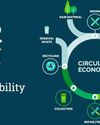Closed-Loop Recycling: From Trash To Treasure
July 2025
|Textile Value Chain
The fashion industry, celebrated for its creativity and perpetual transformation, significantly contributes to global waste and pollution.

Introduction
The growth of fast fashion has resulted in millions of tons of textiles being thrown away annually, ultimately landing in landfills or incinerators. This situation has created an urgent demand for sustainable solutions, among which closed-loop recycling stands out as a promising innovation—a system intended to maintain materials in continuous circulation, thereby minimising waste and environmental damage.
Closed-loop recycling offers an alternative to the traditional “take-make-dispose” model by ensuring that textile waste is recovered, processed, and transformed into new garments. This approach conserves valuable resources and significantly reduces the fashion industry's carbon footprint. This article will explore the concept of closed-loop recycling, its benefits, challenges, and the brands leading the way toward a more sustainable future.
Understanding Closed-Loop Recycling
The Linear vs. Circular Fashion Economy
Traditionally, the fashion industry follows a linear economy—a system where clothes are manufactured, used for a short period, and then discarded. This cycle contributes to enormous textile waste and excessive resource consumption. In contrast, closed-loop recycling follows a circular model, ensuring that textiles are continually reused, either by breaking them down into raw materials for new fabrics or repurposing them into new clothing items.
 How Does It Work?
How Does It Work?The closed-loop recycling process involves several key steps:
1. Collection of Used Garments
a. Consumers return old or unwanted clothes through brand take-back programs, donation centres, or textile recycling bins.
2. Sorting and Fibre Identification
هذه القصة من طبعة July 2025 من Textile Value Chain.
اشترك في Magzter GOLD للوصول إلى آلاف القصص المتميزة المنسقة، وأكثر من 9000 مجلة وصحيفة.
هل أنت مشترك بالفعل؟ تسجيل الدخول
المزيد من القصص من Textile Value Chain

Textile Value Chain
EPR in Textiles: Turning Compliance into Opportunity
When the EU Comes to Panipat, It Means One Thing — The World Is Watching
3 mins
November 2025

Textile Value Chain
European Parliament Delegation Visits Panipat Recycling Cluster to Strengthen India-EU Collaboration on Circular Textiles
A high-level delegation from the European Parliament's Committee on International Trade (INTA) visited the Panipat Textile Recycling Cluster — India's largest hub for recycled textiles and circular manufacturing — during their official visit to India.
1 mins
November 2025

Textile Value Chain
Paramount Instruments: Where Innovation Turns Testing into Joy
At Paramount Instruments, innovation isn't just a Pursuit- it's in our DNA.
2 mins
November 2025
Textile Value Chain
Crafting the Future: LMW & Hami Weavelon pioneer Compact Spinning in Polyester
Manmade fibres today form the backbone of the global textile industry, driven by their versatility, performance, and ability to meet the rising demand for both everyday and specialised applications.
3 mins
November 2025

Textile Value Chain
Data is the New Thread: Weaving India's Textile Sector into a Circular Powerhouse
On November 13, 2025, at the 12th Edition of the India and Sustainability Standards (ISS) International Dialogue and Conference held at Bharat Mandapam in New Delhi, representatives from the Home Exporters Welfare Association of India (HEWA) joined industry leaders, policymakers, and international organizations to address a pressing question: How can India's textile sector meet emerging global data requirements while supporting its MSME backbone?
3 mins
November 2025

Textile Value Chain
Rieter Winding Suction Nozzle Upgrade: More Yarn, Less Energy Use
After upgrading the suction nozzles on their 32 winding machines, Sanyang Textile Co., Ltd., China, saw an increase in yarn production of 3% and a reduction of 13% in energy use. The flow-optimised, aerodynamically designed suction nozzle enables efficient upper yarn search and pickup from the package. This results in a 55% reduction in red light percentage and a significant reduction in the operator's workload.
1 mins
November 2025

Textile Value Chain
EU's Extended Producer Responsibility (EPR) Law and Its Implications for India's Textile Industry
The European Union (EU) has approved a new Extended Producer Responsibility (EPR) framework for textiles. This is a major regulatory shift that makes fashion brands and producers accountable for their products' entire lifecycle, from design and production through collection, sorting, recycling and disposal.
9 mins
November 2025

Textile Value Chain
GTE Ahmedabad 2025 Concludes Day 3 with a Huge Footfall
The 38th Garment Technology Expo (GTE) Ahmedabad 2025, co-located with the Lace & Trims Show, wrapped up its third day on an impressive note, recording around 9,700 B2B visitors. The strong industry turnout reaffirmed the expo's role as one of the most influential and business-driven platforms for garment and apparel technology in the western region.
2 mins
November 2025

Textile Value Chain
Reinterpreting Korean Street Fashion through Sustainable Design Practices
A Path through Eco-conscious Urban Fashion
7 mins
November 2025

Textile Value Chain
3D Printing in Textiles Manufacturing: A Game-Changer in Design, Sustainability, and Efficiency
The global textile and apparel industry is undergoing a radical transformation due to the convergence of digital design, advanced material technology, and next-generation manufacturing. Of the latter, few have greater potential to change how textiles are made today than additive manufacturing, better known as 3D printing.
5 mins
November 2025
Listen
Translate
Change font size

